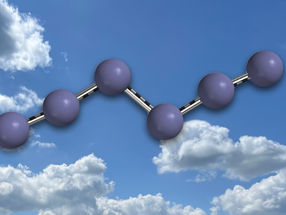A hot tip at low temperatures
Polyester polyurethanes that remain flexible at low temperatures increase safety in cold weather
There is a simple solution when it comes to cold feet: warm shoes. But what happens if the shoes themselves get "cold feet"? It's true that cold conditions take more out of some of the materials used in the soles of footwear than the wearer of the shoe would like, as at sub-zero temperatures many of the elastic materials from which footwear soles are made become brittle and hard. For end users who need to be able to rely upon their footwear in extremely low temperature conditions, Bayer Polymers, a division of Bayer AG, has now introduced a polyester polyurethane material for footwear soles that retains its superior flexibility and flexural strength even at temperatures as low as -30 °C. This new improved Bayflex® coldflex polyurethane system achieves its favorable cold properties and its improved processing capabilities without the use of plasticizers, thus preventing the occurrence of creeping embrittlement as a result of plasticizer migration.
"You can tell whether or not a shoe is of high quality by the way it behaves under low temperature conditions," says Dr. Erhard Michels, a footwear specialist at Bayer Polymers. "Many materials such as PVC, for example, very quickly become brittle at sub-zero temperatures - they become as stiff as a board and this then affects their safety-related properties such as their skid resistance. If we use polyurethanes, however, it is possible to produce sole materials that display excellent flexibility and low rigidity and grip well, even at temperatures as low as -30 degrees Celsius. Until now, manufacturers who had committed themselves to processing polyether polyurethanes that retained their full performance characteristics at low temperatures were the only ones who turned to us. "Meanwhile, however, we have succeeded in developing our polyester polyurethane systems to such an extent that they are easily able to surpass the record performances at low temperatures of their polyether counterparts, with no detrimental effect on their properties at normal temperatures. This has meant that we have been able to enhance the capabilities of those using esters by a considerable margin," says Dr. Michels.
Most of all, Bayer is responding to the wishes of footwear manufacturers in Eastern Europe. It was possible to adapt the product in this way by means of a well thought-out adjustment of the polyol component that goes to make the Bayflex system. "What is important is that we are able to achieve improved flexibility at low temperatures without the addition of plasticizers," Dr. Michels emphasizes. The high flexural strength at minus 30 °C also endures and endures, as the polyurethane material does not undergo any adverse changes as a result of plasticizer migration.
In addition, the optimum polyol formulation enhances the flowability in the mold of the coldflex polyurethane system. This also enhances the processability of the product, as the viscosities required for the mold-filling process can now be achieved at lower temperatures. The densities that can be achieved with the improved polyurethane system lie between 400 kg/m3 and 600 kg/m3 (for midsoles) or 850 to 1100 kg/m3 (for outsoles). The hardness grades that are used cover the range between 40 to 70 Shore A. Antistatic treatments are also possible. With Bayflex coldflex systems, it is possible to meet all of the requirements of European Standard EN 344.
Most read news
Topics
Organizations
Other news from the department research and development

Get the chemical industry in your inbox
By submitting this form you agree that LUMITOS AG will send you the newsletter(s) selected above by email. Your data will not be passed on to third parties. Your data will be stored and processed in accordance with our data protection regulations. LUMITOS may contact you by email for the purpose of advertising or market and opinion surveys. You can revoke your consent at any time without giving reasons to LUMITOS AG, Ernst-Augustin-Str. 2, 12489 Berlin, Germany or by e-mail at revoke@lumitos.com with effect for the future. In addition, each email contains a link to unsubscribe from the corresponding newsletter.





























































